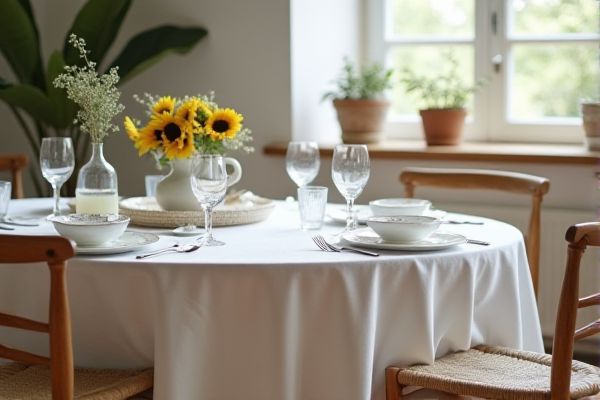
Linen tablecloths offer superior durability and natural wrinkle resistance, creating an elegant, textured look, while cotton tablecloths provide softness and easy maintenance with a variety of patterns and colors. Discover which fabric best suits Your dining needs and aesthetic preferences by reading the rest of the article.
Table of Comparison
| Feature | Linen Tablecloth | Cotton Tablecloth |
|---|---|---|
| Material | Made from flax fibers | Made from cotton fibers |
| Durability | Highly durable, long-lasting | Moderately durable, may wear faster |
| Texture | Coarse, natural texture | Smoother, softer feel |
| Absorbency | Highly absorbent | Moderately absorbent |
| Maintenance | Requires gentle wash, often ironed | Easy to wash, machine friendly |
| Wrinkle Resistance | Wrinkles easily, needs frequent ironing | More wrinkle-resistant |
| Appearance | Elegant, natural sheen | Casual, matte finish |
| Price | Generally more expensive | More affordable |
| Environmental Impact | Eco-friendly, biodegradable | Biodegradable, less eco-friendly cultivation |
Introduction: Linen vs Cotton Tablecloths
Linen tablecloths offer a natural luster and exceptional durability, made from flax fibers that resist wear and stains better than many fabrics. Cotton tablecloths provide softness and ease of care, with high absorbency and a wide range of patterns and colors suitable for everyday use. Your choice depends on whether you prioritize the elegant texture and long-lasting quality of linen or the versatile comfort and affordability of cotton.
Material Origins and Fabric Composition
Linen tablecloths are crafted from flax fibers, a natural plant-based material known for its durability and moisture-wicking properties, while cotton tablecloths originate from cotton fibers, a soft and breathable crop widely cultivated for textile use. The fabric composition of linen results in a textured, slightly crisp finish that softens with use and laundering, whereas cotton offers a smooth, flexible surface with excellent absorbency. Differences in fiber structure influence wrinkle resistance, strength, and longevity, making flax-based linen more robust and cotton more versatile for everyday dining settings.
Texture and Feel: Linen vs Cotton
Linen tablecloths offer a crisp, textured feel with natural irregularities that provide a luxurious, breathable surface ideal for elegant dining settings; in contrast, cotton tablecloths present a softer, smoother texture with a more uniform weave, delivering a cozy and flexible fabric suited for everyday use. Linen's fibers are stronger and have a slight stiffness that softens over time, enhancing durability, whereas cotton tends to be more pliable immediately but may wear faster with frequent washing. The tactile contrast between linen's unique, slightly coarse weave and cotton's consistent softness influences the sensory experience, impacting choice based on aesthetic and comfort preferences.
Durability and Longevity Comparison
Linen tablecloths offer superior durability due to their strong natural fibers, which become softer and more resilient with each wash, often lasting decades with proper care. Cotton tablecloths provide good longevity but tend to wear out faster, especially under frequent washing and heavy use, as their fibers are less resistant to abrasion. Choosing linen ensures a long-lasting, high-quality option ideal for both everyday and formal settings.
Stain Resistance and Maintenance
Linen tablecloths are naturally more stain-resistant due to their dense fibers, making spills easier to clean without setting in quickly. Cotton tablecloths absorb stains faster but are often easier to treat with common household detergents and bleach solutions. To maintain Your linen tablecloth, gentle washing and avoiding harsh chemicals preserve its texture, while cotton offers higher durability in frequent, machine-wash cycles.
Aesthetic Appeal and Color Options
Linen tablecloths offer a natural, textured aesthetic that enhances rustic or elegant table settings, with colors often leaning towards muted, earthy tones due to the fabric's natural fibers. Cotton tablecloths provide a smoother, more uniform appearance and come in a broader spectrum of vibrant colors and patterns, allowing Your dining area to easily match various decor styles. Choosing between linen and cotton depends on whether You prioritize subtle, timeless beauty or diverse, vivid color options for Your table setting.
Environmental Impact and Sustainability
Linen tablecloths are made from flax plants, which require less water and pesticides compared to cotton, making them a more sustainable choice for environmentally-conscious consumers. Cotton cultivation often involves high water consumption and chemical use, contributing to soil degradation and pollution. Choosing a linen tablecloth can reduce your ecological footprint due to its natural biodegradability and lower resource demands during production.
Price and Cost Effectiveness
Linen tablecloths generally come with a higher price tag due to the labor-intensive production and natural fiber quality, but their durability and stain resistance make them cost-effective for long-term use. Cotton tablecloths are more affordable upfront and easier to maintain, yet they may require more frequent replacement because of their lower resilience to wear and tear. Your choice between linen and cotton should balance initial cost against longevity and maintenance expenses to optimize value.
Popular Uses and Occasions
Linen tablecloths are favored for formal dining settings and special occasions due to their elegant texture and natural luster, often seen at weddings, upscale restaurants, and holiday dinners. Cotton tablecloths are popular for everyday use and casual gatherings because of their durability, ease of care, and affordability, making them ideal for family meals, picnics, and informal parties. Both fabrics serve distinct purposes, with linen offering a refined appearance and cotton providing practicality and comfort.
Choosing the Right Tablecloth for Your Needs
Linen tablecloths offer exceptional durability and natural stain resistance, making them ideal for formal dining and special occasions, while cotton tablecloths provide a softer, more affordable option suitable for everyday use and easy maintenance. The breathability and moisture-wicking properties of linen enhance its suitability for warm climates, whereas cotton's versatility and wide range of patterns cater to casual, family-friendly settings. Choosing the right tablecloth depends on factors such as desired texture, frequency of use, and care preferences, with linen excelling in elegance and longevity and cotton favored for comfort and affordability.
 homyna.com
homyna.com